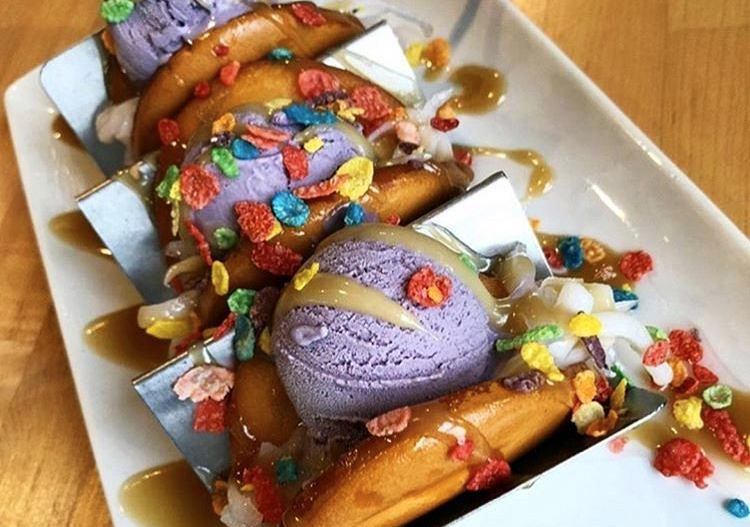Originally published in the October 2018 issue of (614) Magazine

Let’s be honest. You’re probably better off not knowing what happens behind the scenes in most restaurants. But sometimes you should. And that’s the case with Cameron Mitchell Restaurants, whose bona fide empire of Columbus-based brands has arguably enhanced our culinary scene’s national credibility.
From Cap City to The Pearl, Marcella’s to Molly Woo’s—on the surface, their concepts couldn’t be more different. The thread that binds them together is their training, and not just the kind you get in the kitchen or on the house floor.
Between colossal chains and dinky diners, the American restaurant industry is absolutely inordinate, racking up more in annual sales than airlines, agriculture, and the movie industry combined. Nearly half of us have worked in food service at some point. Often it’s our first job, something on the side when times are tight, or just enough hours in retirement to stay active and connected to our community.
But for others, it’s a first calling, or a passion stumbled into on the way to something else. And if that’s you, Cameron Mitchell might be the best mentor in Columbus—maybe anywhere—because he’s been there.
There’s a fine line between corporate culture and a corporate cult, and I have to confess as an outsider slipping into the second story ballroom at The Joseph among the new staff of the then pending Harvey & Ed’s, I wasn’t sure exactly what to expect. I’d paid my dues decades ago on both sides of the grill, but never in posh digs like these. I presumed it would be all about teambuilding and imbuing everyone with a shared purpose. But it was much more intimate and illuminating than I ever anticipated.
Cameron Mitchell Restaurants fosters legendary loyalty, with most leadership promoted from within. But how they build that fierce following has always been behind a curtain. Would it go too far and get weird? Should I be ready for some trust falls or prepare for a trunk full of kitsch and delusional enthusiasm like those leaving an Amway seminar?
Fortunately, this wasn’t either of those scenarios, far from it. And it was surely no canned college orientation either, though the sense of camaraderie was pretty close. No, that loyalty starts with the guy whose name is on every paycheck—Cameron Mitchell, the headliner and head honcho all rolled into one.
With a brand that has become locally synonymous with fine dining, Cameron Mitchell wasn’t supposed to succeed by every empirical predictor. He didn’t have the grades, the money, or the work ethic to keep a job, much less create them. (His restaurant ranks now top 4,000 employees and counting.)
It’s an unlikely story, but one he shares with a surprising honesty and humility with those just starting out in the industry he’s helped to innovate, despite his early struggles and shortcomings, personal and professional.
“I remember coming home from school when I was nine and asking my mom when my dad was coming home, and she said, ‘He’s not’,” Mitchell recalled. “That’s how I learned my parents were splitting up.”
He saw less and less of his father over time before fading from the picture entirely, and the stress of the situation often put him at odds with his mother. School wasn’t a priority and by junior high he’d already fallen in with the wrong crowd—smoking, drinking, and worse.
“I was spiraling downward. My mom and I were fighting constantly. I came home one day and she said, ‘Tomorrow we have a meeting with Franklin County Childrens Services; we’re going to straighten you out,’” he revealed. “I wasn’t really sure what that meant, but I didn’t like it. So when she left for work the next morning, I took everything I could and moved out.”
Mitchell settled in a tiny apartment near campus that was a flophouse for runaways, over-occupied to keep everyone’s share of the rent low. He was only 15-years-old, and on his own.
“I’d work odd jobs, mow lawns. I stole and sold drugs,” he confessed. “At one point, I hadn’t eaten for a few days, so bought a 27-cent box of macaroni and cheese and made it without any milk or butter, just water. I was a troubled kid, on the run.”
Out of money and options, Mitchell eventually returned and reconciled with his mother. He went back to school the following day, wearing a dress shirt and slacks, the only clothes he’d left behind, having come home with only jeans and the t-shirt on his back.
“My mom was an administrative assistant, and my dad had quit sending any child support, so she literally couldn’t afford to send me lunch money,” he admitted. “For a while, I worked in the school cafeteria just to earn enough to eat there.”
He picked up a part-time job after school washing dishes at a local steakhouse, but his grades still suffered. He failed the same English composition course three times and wasn’t able to walk for graduation, only barely earning a diploma after summer school.
“I graduated 592nd out of 597 in my class with a GPA of 1.05; only because I got one C—in public speaking,” he chided. “That’s when I went to work at Max & Erma’s as a fry cook.”
Back in 1981, Max & Erma’s wasn’t the struggling shadow of its former self that it is today. Some nights they’d serve upwards of 1,000 guests on a weekend. It was bustling and brisk, with an energy Mitchell ultimately embraced after his friends mostly left for college or better jobs elsewhere.
“I was working a double shift, an AM cook and a PM host, on a Friday afternoon. The place was about half full at 4 p.m. during the shift change, and the bar was already packed. There was pandemonium in the kitchen. The managers were barking orders, and I looked out across the line and time froze,” he recalled. “I decided this was what I wanted to do with the rest of my life. I wanted to be in the restaurant business.”
The “laziest guy in the kitchen,” by his own admission, had finally found his calling and wasted no time. At the end of his shift, he went home and mapped out the next decade of his life on paper, as well as the goals it would take to get there, from executive chef to president of a restaurant company.
After picking up a couple of classes at Columbus State, he was accepted at the Culinary Institute of America in New York after an initial rejection due to his lackluster high school performance. Returning to Columbus, he landed a new job at 55 at Crosswoods, the restaurant group’s second location, which at the time was among the premiere white tablecloth restaurants in the city. From sous chef to executive chef by age 23, general manager a year later, and an operations executive by 28, his unlikely rise reached a hard and sudden stop.
“I started hitting my head on the ceiling. I knew my boss wasn’t going anywhere, and it was a hip-pocket business for a group of investors who really didn’t care about the restaurants,” he explained. “I was waiting on a friend for drinks watching patrons and employees pass by when I had another epiphany. If I wanted to become president of a restaurant group, I should start my own.”
Mitchell tapped into the insight of his younger self, this time mapping out the future of the company that would ultimately bear his name. Though most won’t believe it, Cameron Mitchell Restaurants was started out of an apartment at The Continent with a few thousands dollars in savings and a yellow legal pad.
Now with industry connections and a proven track record, he pulled together a business plan and the financing needed to make his destiny a reality. But it nearly fell apart, twice.
“It was never my goal to open just one restaurant. This was the start of something bigger. I found a space near the North Market and put a deal together,” he revealed. “I’d raised $600k for the project, and we were ready to sign the lease. Then the landlord went silent on me.”
Mitchell was bootstrapping the project with every dime he could scrape together just as his fears were confirmed. The building’s owner was filing for bankruptcy. The bank was taking it over and had no interest in assuming any further risk with a first-time restaurateur still shy of 30.
The setback was crushing, worse by having come so close. Mitchell started sending investors back their checks. He’d put everything into the project, even moving back into his mother’s condo, but practically living at Kinko’s. There was another space in Worthington he’d initially discounted when he couldn’t pull the financing together fast enough. But because of the legalities of creating a company, he essentially had to start over from scratch.
“I’d already dismissed it, but then their tenant fell through. I met with the landlord, who took a liking to me and decided to take a chance,” he admitted. “I was rolling change on my mother’s dining room table to have enough money for groceries. It was do or die.”
Enough investors still had faith in the restaurant concept to get close to the necessary funding to move forward. But the change in location and way the previous deal collapsed forced some to sit this one out. Mitchell was still short and scrambled to schedule one final meeting with a prospective investor to close the gap the day before the financing was due.
“He asked me how much. I told him I only needed $30k, hoping I might get half of it and have enough to buy some more time to raise the rest,” he confessed. “He wrote me a personal check for $30k and told me to buy more stock in the company for myself. That’s when I knew I’d get my start.”
Cameron Mitchell Restaurants was born, and that first project that nearly never happened, is Cameron’s American Bistro, celebrating its 25th anniversary this October.
Since then, new concepts have become part of the family, as well as a catering company and their own restaurant construction business. Rusty Bucket Restaurant and Tavern and Ocean Prime have expanded the brand nationwide.
“I think it’s important to know the history of the company, one based on people. Associates come first. Associates take care of the guests, guests take care of the company,” he explained. “That’s the key, a company built on culture and values—not on me—one that I hope will survive long after I’m gone.” ▩








